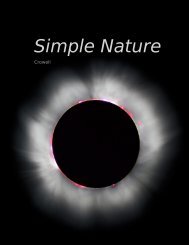The size of a radio antenna is closely related to ... - Light and Matter
The size of a radio antenna is closely related to ... - Light and Matter
The size of a radio antenna is closely related to ... - Light and Matter
You also want an ePaper? Increase the reach of your titles
YUMPU automatically turns print PDFs into web optimized ePapers that Google loves.
at rest relative <strong>to</strong> the water. But light <strong>is</strong>n’t a vibration <strong>of</strong> a physical<br />
medium; it can propagate through the near-perfect vacuum <strong>of</strong> outer<br />
space, as when rays <strong>of</strong> sunlight travel <strong>to</strong> earth. Th<strong>is</strong> seems like a<br />
paradox: light <strong>is</strong> supposed <strong>to</strong> have a specific speed, but there <strong>is</strong> no<br />
way <strong>to</strong> decide what frame <strong>of</strong> reference <strong>to</strong> measure it in. <strong>The</strong> way<br />
out <strong>of</strong> the paradox <strong>is</strong> that light must travel at a velocity equal <strong>to</strong> c.<br />
Since all observers agree on a velocity <strong>of</strong> c, regardless <strong>of</strong> their frame<br />
<strong>of</strong> reference, everything <strong>is</strong> cons<strong>is</strong>tent.<br />
u / A ring laser gyroscope.<br />
<strong>The</strong> Michelson-Morley experiment<br />
<strong>The</strong> constancy <strong>of</strong> the speed <strong>of</strong> light had in fact already been<br />
observed when Einstein was an 8-year-old boy, but because nobody<br />
could figure out how <strong>to</strong> interpret it, the result was largely ignored.<br />
In 1887 Michelson <strong>and</strong> Morley set up a clever apparatus <strong>to</strong> measure<br />
any difference in the speed <strong>of</strong> light beams traveling east-west <strong>and</strong><br />
north-south. <strong>The</strong> motion <strong>of</strong> the earth around the sun at 110,000<br />
km/hour (about 0.01% <strong>of</strong> the speed <strong>of</strong> light) <strong>is</strong> <strong>to</strong> our west during the<br />
day. Michelson <strong>and</strong> Morley believed that light was a vibration <strong>of</strong> a<br />
mysterious medium called the ether, so they expected that the speed<br />
<strong>of</strong> light would be a fixed value relative <strong>to</strong> the ether. As the earth<br />
moved through the ether, they thought they would observe an effect<br />
on the velocity <strong>of</strong> light along an east-west line. For instance, if they<br />
released a beam <strong>of</strong> light in a westward direction during the day, they<br />
expected that it would move away from them at less than the normal<br />
speed because the earth was chasing it through the ether. <strong>The</strong>y were<br />
surpr<strong>is</strong>ed when they found that the expected 0.01% change in the<br />
speed <strong>of</strong> light did not occur.<br />
<strong>The</strong> ring laser gyroscope example 5<br />
If you’ve flown in a jet plane, you can thank relativity for helping<br />
you <strong>to</strong> avoid crashing in<strong>to</strong> a mountain or an ocean. Figure u<br />
shows a st<strong>and</strong>ard piece <strong>of</strong> navigational equipment called a ring<br />
laser gyroscope. A beam <strong>of</strong> light <strong>is</strong> split in<strong>to</strong> two parts, sent<br />
around the perimeter <strong>of</strong> the device, <strong>and</strong> reunited. Since the speed<br />
<strong>of</strong> light <strong>is</strong> constant, we expect the two parts <strong>to</strong> come back <strong>to</strong>gether<br />
at the same time. If they don’t, it’s evidence that the device has<br />
been rotating. <strong>The</strong> plane’s computer senses th<strong>is</strong> <strong>and</strong> notes how<br />
much rotation has accumulated.<br />
No frequency-dependence example 6<br />
Relativity has only one universal speed, so it requires that all light<br />
waves travel at the same speed, regardless <strong>of</strong> their frequency<br />
<strong>and</strong> wavelength. Presently the best experimental tests <strong>of</strong> the invariance<br />
<strong>of</strong> the speed <strong>of</strong> light with respect <strong>to</strong> wavelength come<br />
from astronomical observations <strong>of</strong> gamma-ray bursts, which are<br />
sudden outpourings <strong>of</strong> high-frequency light, believed <strong>to</strong> originate<br />
from a supernova explosion in another galaxy. One such observation,<br />
in 2009, 3 found that the times <strong>of</strong> arrival <strong>of</strong> all the different<br />
3 http://arxiv.org/abs/0908.1832<br />
396 Chapter 7 Relativity














